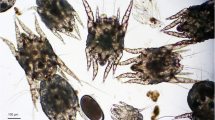Summary
Otacariasis due to Otodectes cynotis (HERING, 1858) is a very frequent disease of the external ear canal in cats. Otodectes cynotis is the most common mange mite in carnivores. Several antiparasiticides are licensed for treatment. The purpose of this study was to evaluate the efficacy of a formulation containing selamectin (Stronghold® Spot-on) for eradication of ear mites in cats under field conditions. Sixteen cats with otacariasis, presented in a small animal clinic, were treated with a single spot-on application of selamectin (Stronghold® Spot-on, 6–17.3 mg/kg bdw.). On clinical and parasitological assessment days 14 and 28 clinical signs had subsided in ten cats. Furthermore all ear swabs were negative for mites and their developmental stages on D 14 and D 28. Selamectin was a practical and well-tolerated treatment of feline otacariasis for the cats included in this study. It was very well tolerated in all cats, local skin irritations on the neck did not occur.
Zusammenfassung
Die Ohrräude, verursacht durch Otodectes cynotis (HERING, 1858), ist eine sehr häufige Erkrankung des äußeren Gehörganges bei Katzen. Otodectes cynotis kann als die verbreitetste Räudemilbe bei Fleischfressern angesehen werden. Für die Behandlung können verschiedene Antiparasitika verwendet werden. Ziel der vorliegenden Wirksamkeitsstudie war die Evaluierung von Selamectin (Stronghold® Spot-on) bei der Tilgung von Ohrräudemilben bei Katzen unter Feldbedingungen. Es wurden 16 Katzen mit Ohrmilbenbefall (Otodectes cynotis), die in der regulären tierärztlichen Kleintiersprechstunde vorgestellt wurden, einmalig mit jeweils 6–17,3 mg/kg KM Selamectin (Stronghold® Spot-on) therapiert. Bei den Kontrollen am Tag 14 und Tag 28 post applicationem konnten bei keiner der Katzen mehr Ohrmilben oder deren Entwicklungsstadien nachgewiesen werden. Auch die klinischen Symptome waren bei zehn Tieren weitgehend abgeklungen. Das applizierte Selamectin (Stronghold® Spot-on) erzielte eine 100%ige Beseitigung der Otodectes-cynotis-Milben bei den therapierten Katzen. Die Spot-on-Applikation erwies sich als praktikable Anwendung zur Therapie der felinen Ohrräude. Der Wirkstoff wurde von allen Patienten sehr gut vertragen, ohne dass lokale Hautirritationen an der Applikationsstelle auftraten.
Similar content being viewed by others
Literatur
Kraft W, Kraiss-Gothe A, Gothe R (1988) Die Otodectes-cynotis-Infektion von Hund und Katze: Erregerbiologie, Epidemiologie, Pathogenese und Diagnose sowie Fallbeschreibungen generalisierter Räuden bei Hunden. Tierärztl Prax 6: 409–15
Carlotti DN (1991) Diagnosis and medical treatment of otitis externa in dogs and cats. J Small Anim Pract 32: 394–400
Beck W (2001) Ohrräude durch Otodectes cynotis (Acari: Psoroptidae) beim Frettchen – Erregerbiologie, Pathogenese, Klinik, Diagnose und Therapie. Kleintierprax 46: 31–4
Hiepe T, Ribbeck R (1982) Veterinärmedizinische Arachno-Entomologie. In: Lehrbuch der Parasitologie. Hiepe T (Hrsg) Gustav Fischer, Stuttgart, pp 154–55
Sotiraki ST, Koutinas AF, Leontides LS, Adamama-Moraitou KK, Himonas CA (2001) Factors affecting the frequency of ear canal and face infestation by Otodectes cynotis in the cat. Vet Parasitol 96: 309–15
Lautner S (1987) Zur Bekämpfung der Notoedres- und Otodectesräude bei der Katze mit Ivermectin. Vet Diss Wien
Nie JA, Pick CR (1978) Infestation of a colony of ferrets with ear mite (Otodectes cynotis) and its control. J Inst Anim Tech 29: 63–8
Olson GA (1973) Acarine otitis in the ferret. Lab Anim Dis 8: 84–7
Preisler J (1985) Incidence of ear mites Otodectes cynotis on some carnivores in the territory of C?SR. Folia Parasitol (Praha) 32: 82
Van de Heyning J, Thienpont D (1977) Otitis externa in man caused by the mite Otodectes cynotis. Laryngoscope, 1938–41
Tonn RJ (1961) Studies on the ear mite Otodectes cynotis, including life cycle. Ann Entomol Soc Ann 54: 416–21
Sweatman GK (1958) Biology of Otodectes cynotis, the ear cancer mite of carnivores. Can J Zool 36: 849–62
Larkin AD, Gaillard GE (1981) Mites in cat ears: a source of cross antigenicity with house dust mites. Preliminary report. Ann Allergy 46: 301–3
Curtis CF (2004) Current trends in the treatment of Sarcoptes, Cheyletiella and Otodectes mite infestations in dogs and cats. Vet Dermatol 15: 108–14
Vincenzi P, Genchi C (1998) Efficaté du fipronil (Frontline Spot on n.d.) dans le traitement de la gale des oreilles (Otodectes cynotis) chez le chien et le chat. Journées annuelles GEDAC/GTDV, Lille, 27.–29.3.1998
Beck W (2001) Ohrräude beim Kaninchen durch Psoroptes cuniculi – Erfahrungen zur Therapie mit Selamectin (Stronghold®). Kleintiermed 4: 200–3
Shanks DJ, McTier TL, Rowan TG, Watson P, Thomas CA, Bowman DD, Hair JA, Pengo G, Genchi C, Smothers CD, Smith DG, Jernigan AD (2000) The efficacy of selamectin in the treatment of naturally acquired aural infestations of Otodectes cynotis on dogs and cats. Vet Parasitol 91: 283–90
Six RH, Clemence RG, Thomas CA, Behan S, Boy MG, Watson P, Benchaoui HA, Clements PJM, Rowan TG, Jernigan AD (2000) Efficacy and safety of selamectin against Sarcoptes scabiei on dogs and Otodectes cynotis on dogs and cats presented as veterinary patients. Vet Parasitol 91: 291–309
Author information
Authors and Affiliations
Corresponding author
Rights and permissions
About this article
Cite this article
Beck, W. Feldstudie zur Therapie der Felinen Ohrräude verursacht durch Otodectes cynotis mit Selamectin (Stronghold®). Wien Klin Wochenschr 122 (Suppl 3), 76–80 (2010). https://doi.org/10.1007/s00508-010-1442-x
Published:
Issue Date:
DOI: https://doi.org/10.1007/s00508-010-1442-x




